This is a perfect cheesecake with sour cream. It's smooth and creamy, uses few ingredients, it's hard to mess up and is a crowd-pleasing dessert. It was my go-to recipe for years, and I can't believe I'm posting it almost a decade after starting this blog! It was worth the wait.
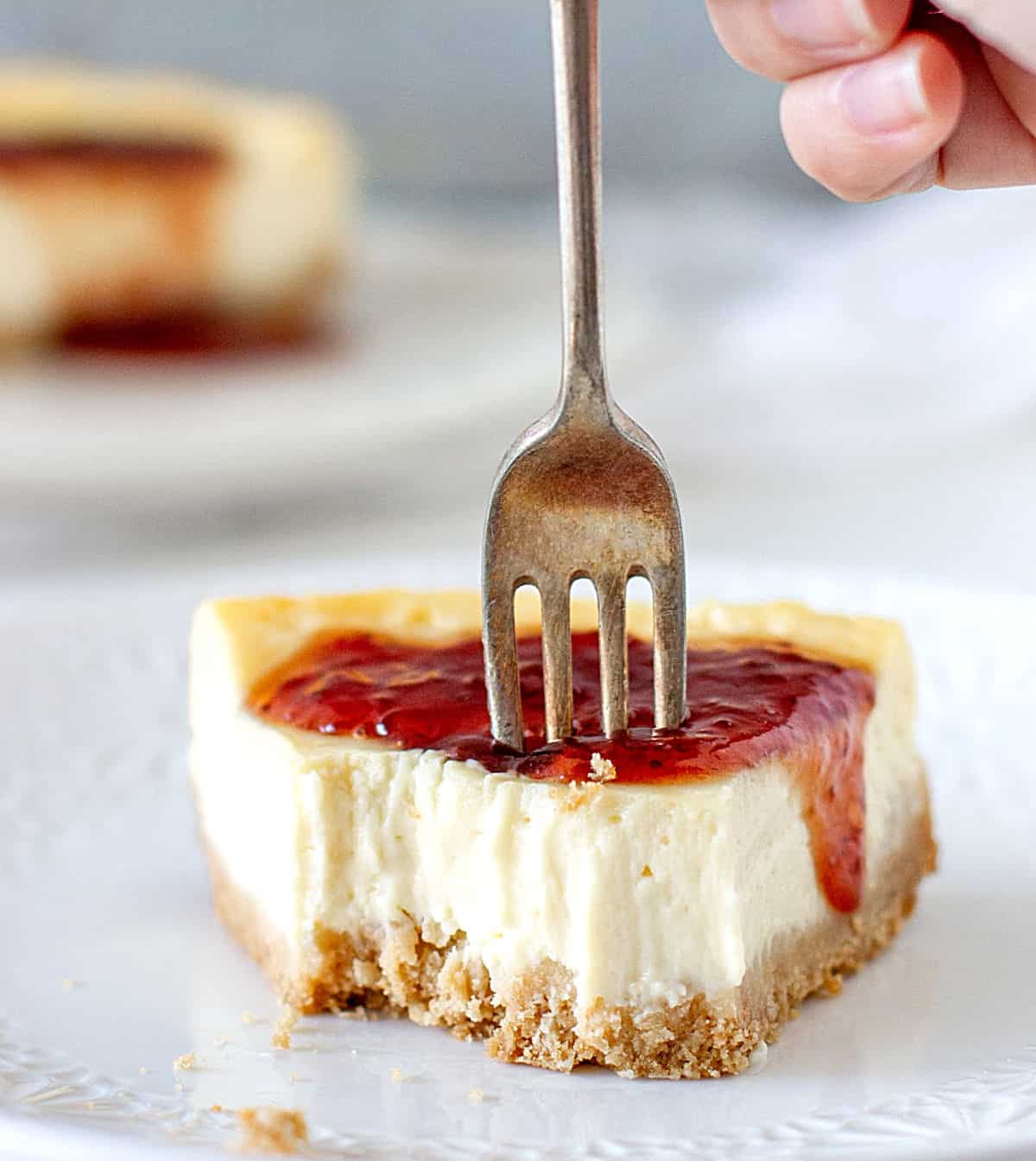
Why call it a sour cream cheesecake?
The higher amount of sour cream, which competes directly with the amount of cream cheese, separates it from a classic cheesecake recipe.
This recipe uses almost the same amount for both, making it a cheesecake recipe with sour cream, for sure.
This is the first cheesecake I ever made when I started baking, and the only one I made for years. It embodies my strong beliefs about cheesecake: few ingredients, a smooth and creamy filling, and a no-fuss buttery graham cracker crust.
You might or might not have realized that I'm a cheesecake fanatic, a complete groupie, and a purist.
I like cheesecakes to taste like sweet cheese, and if I'm making a flavored version, the ingredients I add are necessary; there's no fluff. So you will hardly see flour, cornstarch, or gelatin in my cheesecake recipes.
Watch the step-by-step video recipe
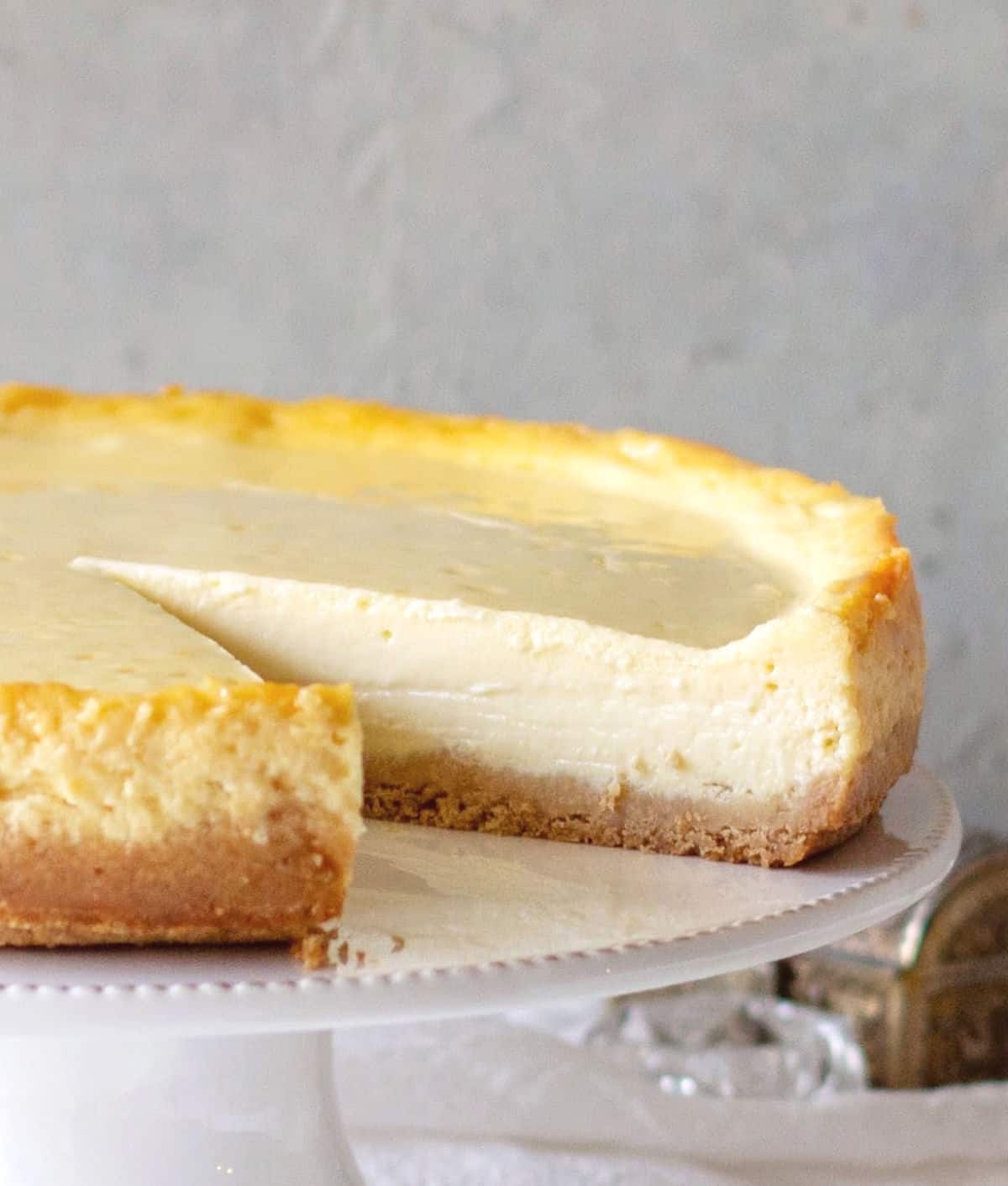
Why use sour cream in a cheesecake
Most old-fashioned recipes have a sour cream topping. A layer on top of the cheesecake was added during the last minutes of baking.
We add it to the cheese mixture instead. Why?
- Tanginess: it gives the cheesecake a tang that balances the sweetness nicely and is characteristic of cheesecakes.
- Lighter filling: it softens the cream cheese a bit, so the result is less dense than an all-cream cheese recipe.
FAQ
There are several possible answers: too much beating, overbaking it, and/or a temperature too high, a drastic change in temperature (from the oven to the refrigerator), or it sticking to the sides of the pan and cracking when it started to cool down as the sides couldn't shrink. One or several might be the cause.
Yes, you can. Omit the crust and butter the pan. I have an Orange Ricotta Cheesecake with no-crust in this blog.
I don't use a water bath since my experiences never turned out well; some water inevitably seeped into the crust or filling. That said, you can put a roasting pan with hot water on the oven floor, and the steam will make the environment more humid as the cheesecake bales. Also, a low oven temperature helps achieve a wonderfully smooth and creamy filling.
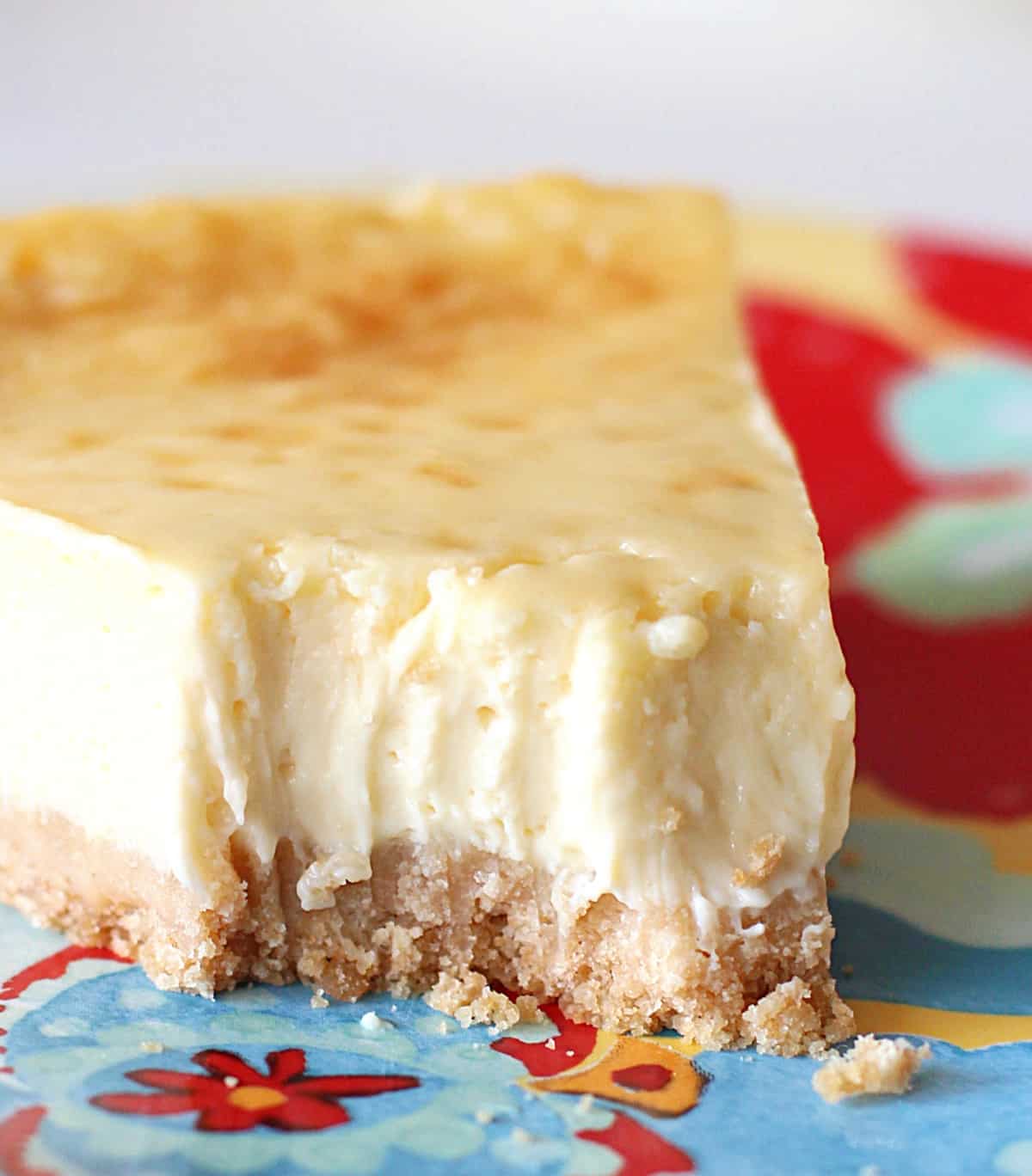
Ingredient list
- Graham crackers.
- Unsalted butter.
- Cream cheese: regular, full-fat cream cheese is needed for consistency and creaminess.
- Sour cream: the regular type, full-fat sour cream cheese is used for richness and creaminess.
- Eggs: fresh, large
- White, granulated sugar.
- Vanilla extract.
Quantities are listed on the recipe card towards the end of this post. The Ingredients page has more details and lists the brands we use.
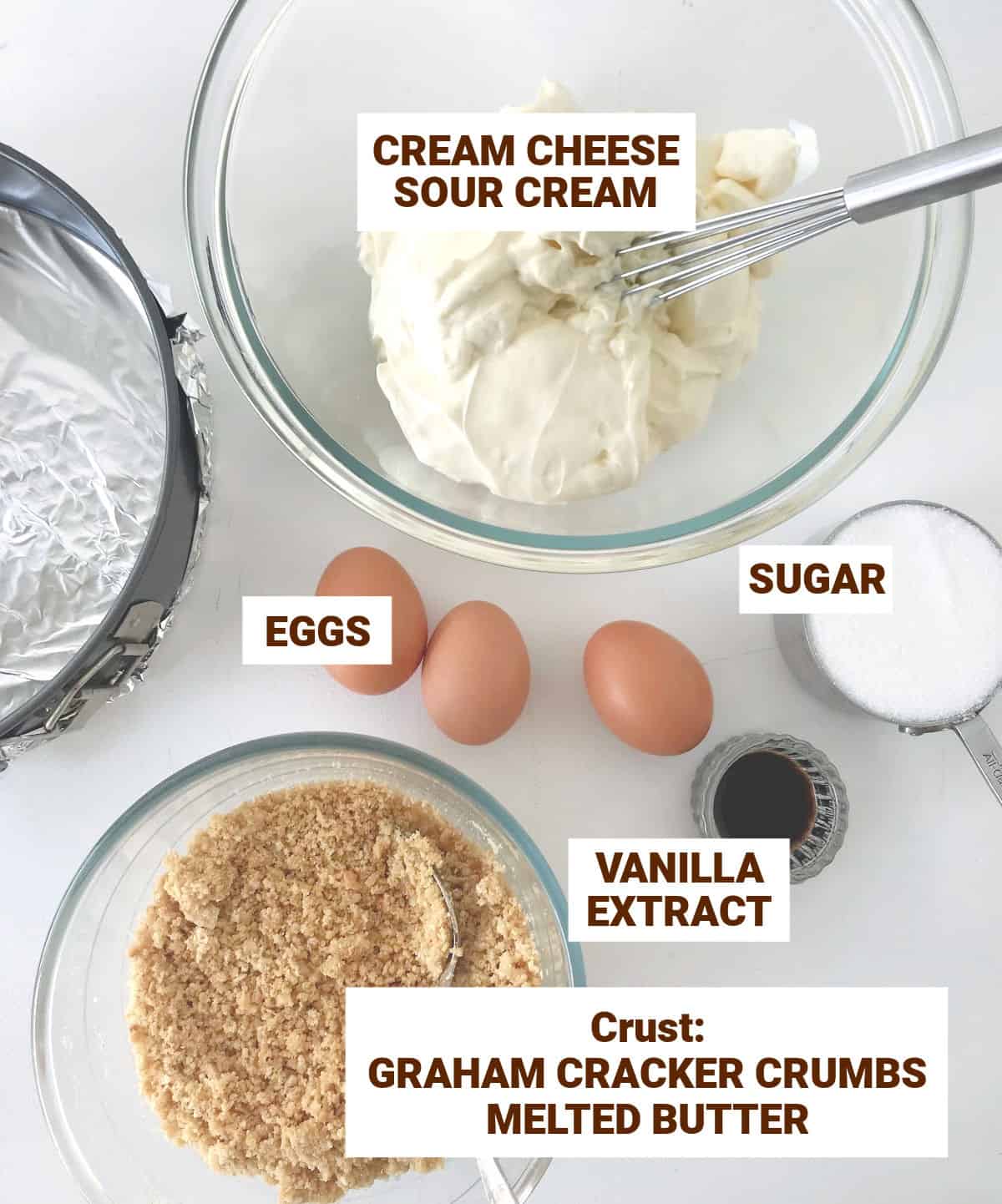
Preparing the pan
I line the bottom of my cake pan with aluminum paper. This makes it super easy to remove.
- Take a large piece of foil a few inches bigger than your pan, press it lightly so that it forms the removable bottom part, and then close the side part over it. The overhanging foil will now be outside the pan.
- Take the foil and wrap it upwards so that it sticks to the sides of the pan.
- When you're ready to remove the cheesecake, take it out of the refrigerator, turn the foil down and remove the springform pan side. Place your open hand between the foil and the bottom of the pan, and lift the whole cheesecake. Since the cake is cold, it will lift easily.
- Peel the foil carefully while still holding the cake in your palm, and place it on the serving plate.
Steps to make a sour cream cheesecake
The cookie crust
We all know by now that this type of crust is the best for cheesecake because it's so darn easy! Mix two ingredients and pat them onto the cheesecake pan. That's it.
- Graham cracker crust is the traditional base for cheesecakes, and for good reason: they pair wonderfully.
- Vanilla wafers or digestive biscuits are an alternative, especially if you live outside the US. They let the filling shine.
The cheesecake batter
A creamy and smooth filling is essential. So use good ingredients, follow instructions closely and, very importantly, pay attention to the cooling process.
- Cooling down process: cheesecakes need to cool down gradually and spend several hours in the refrigerator before being served; that's how we achieve a creamy consistency.
- Mixing equipment: I make the filling by hand, with a whisk and a spatula, which is not hard if the ingredients are at room temperature. You can use an electric mixer for the first part when you need a lump-free cheese mixture. But don't use it after that, as we don't want to incorporate unwanted air. I don't recommend a stand mixer as it tends to overbeat preparations.
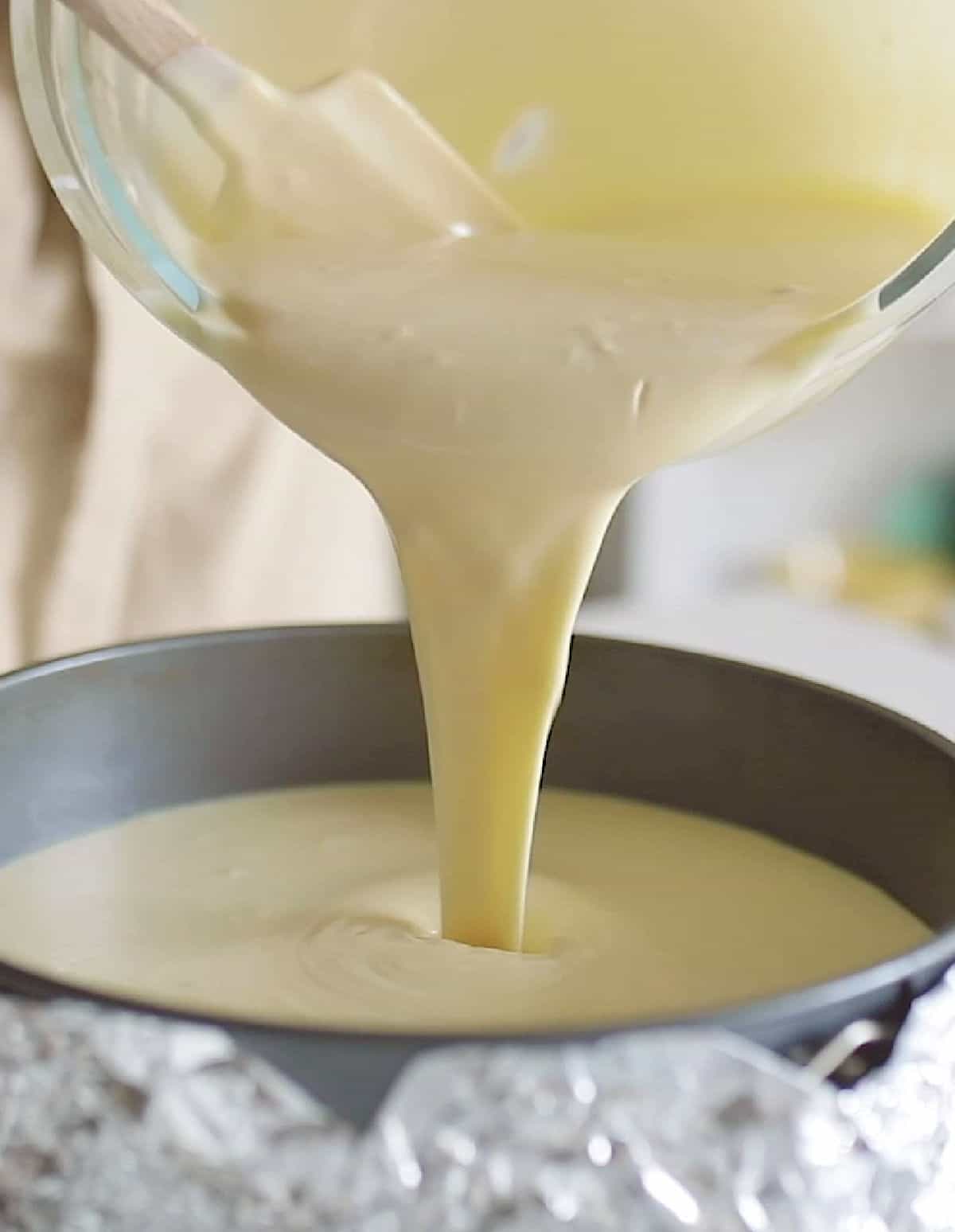
Serving
This is a simple baked cheesecake recipe. You can serve it plain or with a topping.
- Berry sauces will always be my favorites, like this perfect blueberry sauce and this easy strawberry topping.
- Use a more decadent topping like dulce de leche (sweet milk jam) or caramel sauce.
- Fresh fruit: depending on the season, mix fresh berries (as we do with the ricotta cheesecake) or a mix of tropical and stone fruit like mango, pineapple, and peaches.
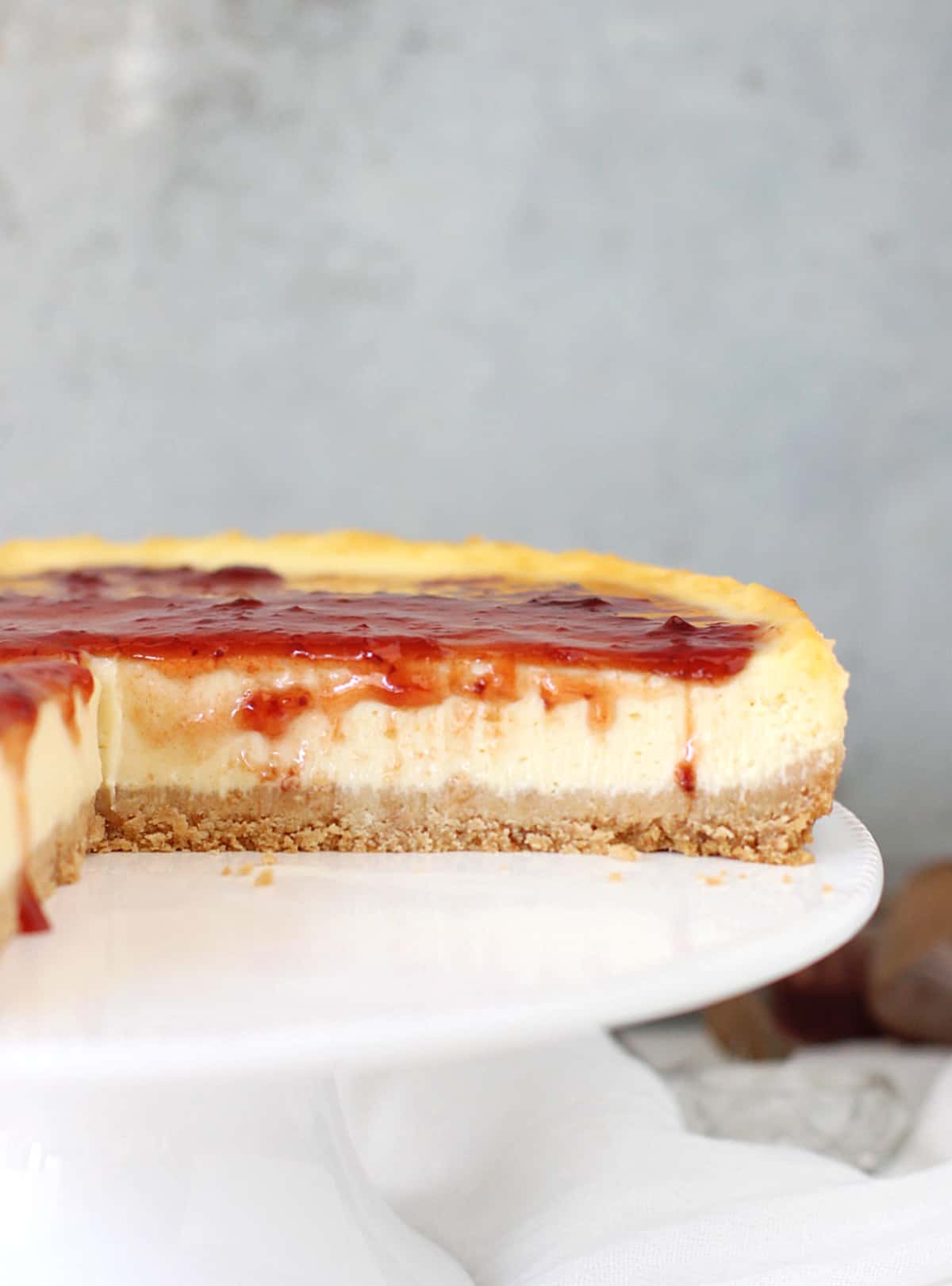
Storage
- Refrigerator: in addition to the mandatory 8 hours in the fridge, you can keep it there for several days, always well wrapped or covered to avoid drying.
- Freezer: this cheesecake was made to be frozen! A friend of mine says it's even better after it. I tend to agree. But keep in mind that you need to first refrigerate it for at least 4 hours before freezing. Well wrapped, it can last up to 2 months.
Kitchen Notes
- Organization: read the recipe first and ensure you have ingredients at the correct temperature, equipment, and enough workspace. This will make the process so much easier.
- Baking time: keep in mind that all ovens and pans are different, even if they look the same or very similar. You can use a thermometer(like the OXO oven thermometer) to check that your oven is at the right temperature.
- Flavorings: vanilla extract or paste are always my first option for a classic cheesecake. But the sky's the limit if you want to add lemon zest and fresh lemon juice, other extracts, spices, or a tablespoon of liqueur.
- Freezing: sometimes I feel that this cheesecake is creamier after being frozen for a week or two. Just to say that it's a great dessert to have frozen. Thaw in the refrigerator and then bring to almost room temperature to eat.
Related recipes you might like:
Before you go
If you made this recipe and loved it, you can comment below and leave a five-star ⭐️ review. Also, if you had issues, let me know so we can troubleshoot together.
You can also subscribe to our FREE email series 'Baking the Best' and our regular newsletter. Or follow and save my recipes on Pinterest.
As an Amazon Associate, I earn from qualifying purchases. Read my disclosure policy.
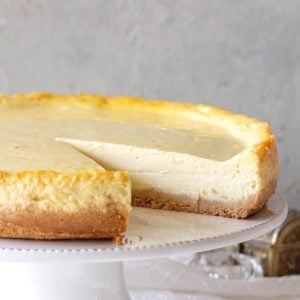
Sour Cream Cheesecake (easy, with video)
Ingredients
For the base:
- 1 ½ cups ground graham crackers, or plain vanilla cookies
- 6 tablespoons unsalted butter, melted
For the cheesecake filling:
- 16 ounces regular cream cheese, at room temperature
- 2 cups sour cream, at room temperature
- 1 cup sugar
- 3 eggs, at room temperature
- 1 tablespoon vanilla extract
Instructions
- Turn the oven to 350°F (180°C).
- If you want, line the bottom of a 9-inch (24cm) cake pan with removable bottom (springform pan). with aluminum foil for easier removal.
For the base:
- Mix 1 ½ cups ground graham crackers with 6 tablespoons unsalted butter, melted, until it looks like wet sand. You can use the food processor to mix both ingredients after you ground the cookies. Pat onto the bottom of the prepared pan, pressing with your hand until it is compact.
- Bake for 10 minutes, until it dries and begins to color lightly. Reserve.
For the cheesecake filling:
- Mix 16 ounces regular cream cheese with 2 cups sour cream in a large bowl until smooth and no lumps remain.
- Add 1 cup sugar and mix until well integrated.
- Add 3 eggs and continue mixing until everything is well combined and creamy. You don’t need to beat because we don’t want to incorporate air into the mixture, but make sure no egg parts remain, especially egg whites which tend to take longer to disintegrate.
- Scrape the sides of the bowl regularly with a spatula to fully integrate the mixture.
- Add 1 tablespoon vanilla extract and mix well. Pour the batter into the prepared pan.
- Bake cheesecake for 30 minutes in the preheated oven. Turn off the oven and leave the cheesecake inside, without opening the oven door, for 1 hour.
- Remove from the oven and cool completely to room temperature on a wire rack.
- Cover it in plastic wrap without removing it from the pan and refrigerate it for at least 8 hours. I recommend a minimum of 1 day. (At this point, it can also be frozen, always well wrapped).
- Run a smooth-bladed knife around the edges and carefully remove the side ring from the pan. If you used aluminum paper, lift the sides and place your open palm beneath the paper and the pan. Lift the whole cheesecake (it’s cold, so it’s firm), carefully unwrap the paper and remove it completely, and place the cheesecake on the serving plate.
- Serve with berry jam, sauce, topping, or fresh berries.
Notes
Refrigerator: besides the mandatory 8 hours in the fridge, you can keep it there for several days, always well wrapped or covered to avoid drying.
Freezer: this cheesecake is ideal to have frozen. A friend of mine says it's even better after it. I tend to agree. But remember that you must first let it cool completely to room temperature and then refrigerate it for at least 4 hours before freezing. Well wrapped, it can last up to 2 months. Flavorings: vanilla extract or paste are always my first option because they are natural (as opposed to artificial essences). But the sky's the limit if you want to add citrus zest, other extracts, and spices.

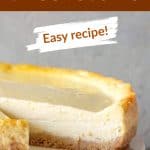
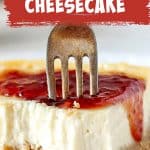
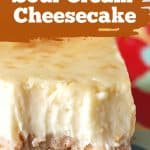
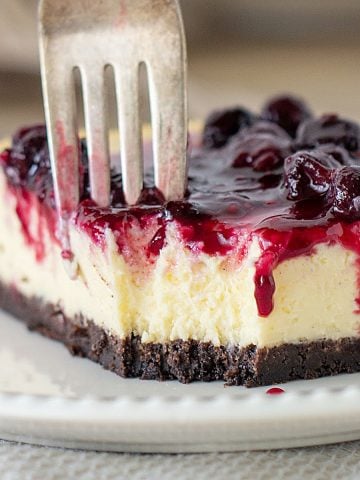
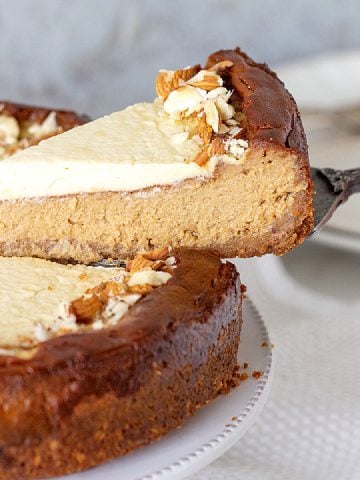
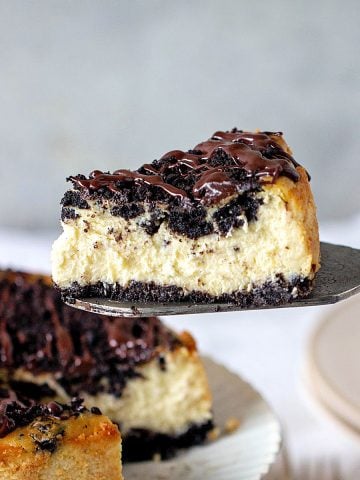
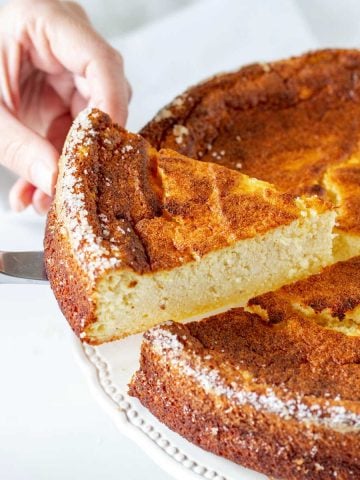
Robin C. Rutan says
A really good versatile basic sour cream recipe. Thank You.
Jeanie Faulkner says
Delicious! X x
Fran says
Made this recipe and it was outstanding. Thank you! Could I half the recipe?
What size pan would be best, if so.
Paula Montenegro says
Hi Fran! Glad you liked it. I would use a 7-inch round pan for half the recipe.
Bruno Ravioli says
You would need to find a (notoriously elusive) 4.5" x 4.5" pan.
Florence says
Coucou Paula !
Je viens de réaliser ce délicieux cheesecake, que du bonheur en bouche . Il est très fondant, à refaire sans hésitation. Il me restait 250 gr de lemon curd que j'avais fait maison, alors je l'ai intégré dans la garniture du cheesecake. Cela fonctionne très bien, je ne suis pas déçu du résultat.
Merci, pour le partage ainsi que toutes vos belles explications très détallées pour la recette.
Amicalement du Canada
Paula Montenegro says
Je suis heureux que cela ait si bien fonctionné Florence et j'adore l'idée d'un tourbillon de crème au citron. Passez de bonnes fêtes de fin d'année!
Jamie Sue Lee says
My cheesecake sunk in the middle. Why would that happen?
Paula Montenegro says
Hi Jamie, it might be due to overbeating the batter, which incorporates too much air, substantial temperature changes causing it to rise and fall rapidly can cause a cheesecake to sink in the middle too much.
Candi Haas says
Is there any reason why I couldn't use monkfruit or Stevia in place of the sugar?
Paula Montenegro says
Hi Candi, I don't know how they work substituting sugar, so I can't really give you an answer. I never worked with them.